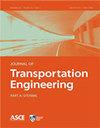新冠肺炎相关出行限制对环境和出行时间可靠性的影响
IF 1.8
4区 工程技术
Q3 ENGINEERING, CIVIL
Journal of Transportation Engineering Part A-Systems
Pub Date : 2023-07-01
DOI:10.1061/jtepbs.teeng-7290
引用次数: 0
摘要
本研究分析了在异质性和无车道交通条件下,为应对冠状病毒传播而实施的交通限制对空气质量和出行时间可靠性的影响。对2019冠状病毒病大流行期间、大流行后和部分限制期间的污染物数量、平均旅行时间分布(TTD)及其相关的旅行时间可靠性(TTR)指标进行了比较分析。使用Wi-Fi传感器和国营空气质量监测站收集了印度钦奈市选定地点的污染物数据(PM2.5、NO2和NOX)和旅行时间数据,为期一周。PM2.5、NO2和NOX的平均值在封城后分别上升了433.1%、681.4%和99.2%。相关分析还表明,所有被考虑的空气污染物都与Wi-Fi连接有一定的相关性,尽管程度不同。从分析中还发现,平均TTD平均值和四分位数差值分别提高了47.2%和105.2%。此外,与这些TTD指标相关的缓冲时间指数、规划时间指数、出行指数和容量缓冲指数在放松旅行限制后分别增加了148.1%、63.7%、42.8%和202.9%。©2023美国土木工程师学会。本文章由计算机程序翻译,如有差异,请以英文原文为准。
Impact of COVID-19–Related Travel Restrictions on the Environment and Travel Time Reliability
This study analyzes the effect of the restrictions in traffic movement enforced in order to combat the spread of coronavirus on air quality and travel time reliability under heterogeneous and laneless traffic conditions. A comparative analysis was conducted to examine quantity of pollutants, average travel time distributions (TTD), and their associated travel time reliability (TTR) metrics during the COVID-19 pandemic, postpandemic, and during partial restrictions. Pollutants data (PM2.5, NO2, and NOX) and travel time data for selected locations from Chennai City in India were collected for a sample period of one week using Wi-Fi sensors and state-run air quality monitoring stations. It was observed that the average quantity of PM2.5, NO2, and NOX were increased by 433.1%, 681.4%, and 99.2%, respectively, during the postlockdown period. Correlation analysis also indicated that all considered air pollutants are moderately correlated to Wi-Fi hits, albeit to varied degrees. From the analysis, it was also found that average TTD mean and interquartile range values were increased by 47.2% and 105.2%. In addition, the buffer time index, planning time index, travel index, and capacity buffer index associated with these TTD metrics were increased by 148.1%, 63.7%, 42.8%, and 202.9%, respectively, soon after relaxing travel restrictions. © 2023 American Society of Civil Engineers.
求助全文
通过发布文献求助,成功后即可免费获取论文全文。
去求助
来源期刊

Journal of Transportation Engineering Part A-Systems
Social Sciences-Transportation
CiteScore
3.80
自引率
14.30%
发文量
152
期刊介绍:
The Journal of Transportation Engineering will be renamed the Journal of Transportation Engineering, Part A: Systems. This change will take effect with the January 2017 issue. The editorial board remains the same and papers in review will continue through the process without delay. A new journal has been launched, Journal of Transportation Engineering, Part B: Pavements. The first issue will appear in 2017.
 求助内容:
求助内容: 应助结果提醒方式:
应助结果提醒方式:


